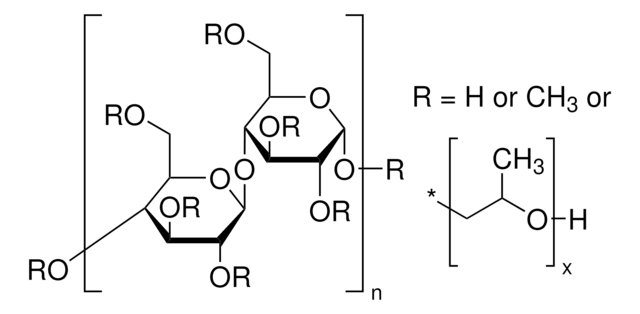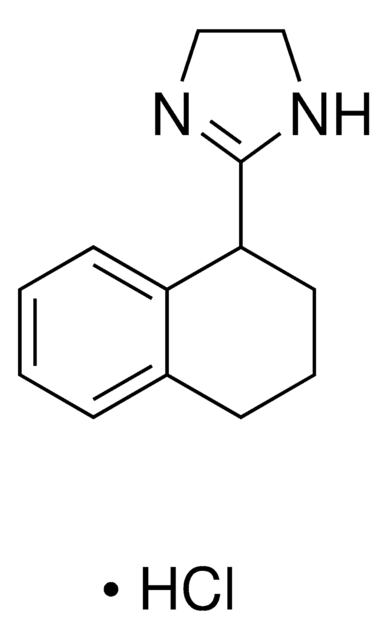Wszystkie zdjęcia(1)
Key Documents
1330005
USP
Hypromellose
United States Pharmacopeia (USP) Reference Standard
Synonim(y):
(Hydroxypropyl)methyl cellulose
Zaloguj sięWyświetlanie cen organizacyjnych i kontraktowych
About This Item
Polecane produkty
klasa czystości
pharmaceutical primary standard
rodzina API
hypromellose
producent / nazwa handlowa
USP
Zastosowanie
pharmaceutical (small molecule)
format
neat
Szukasz podobnych produktów? Odwiedź Przewodnik dotyczący porównywania produktów
Opis ogólny
This product is provided as delivered and specified by the issuing Pharmacopoeia. All information provided in support of this product, including SDS and any product information leaflets have been developed and issued under the Authority of the issuing Pharmacopoeia.For further information and support please go to the website of the issuing Pharmacopoeia.
Zastosowanie
Hypromellose USP Reference standard, intended for use in specified quality tests and assays as specified in the USP compendia. Also, for use with USP monographs such as Hypromellose Ophthalmic Solution
Thickener for aqueous and non-aqueous systems, clear films with grease resistance, binders, lubricants, steric stabilizer and water retention aid.
Cechy i korzyści
Dissolves in water, undergoes reversible gelation upon heating, non-ionic, does not complex with ionic species and is surface active and enzyme resistant. Solutions are pseudoplastic.
Komentarz do analizy
These products are for test and assay use only. They are not meant for administration to humans or animals and cannot be used to diagnose, treat, or cure diseases of any kind.
Inne uwagi
Sales restrictions may apply.
This page may contain text that has been machine translated.
produkt powiązany
Kod klasy składowania
11 - Combustible Solids
Klasa zagrożenia wodnego (WGK)
WGK 1
Temperatura zapłonu (°F)
Not applicable
Temperatura zapłonu (°C)
Not applicable
Certyfikaty analizy (CoA)
Poszukaj Certyfikaty analizy (CoA), wpisując numer partii/serii produktów. Numery serii i partii można znaleźć na etykiecie produktu po słowach „seria” lub „partia”.
Masz już ten produkt?
Dokumenty związane z niedawno zakupionymi produktami zostały zamieszczone w Bibliotece dokumentów.
Klienci oglądali również te produkty
Gülgez Gökçe Yıldız et al.
Journal of bacteriology, 196(10), 1825-1832 (2014-02-25)
The heme-copper superfamily of proton-pumping respiratory oxygen reductases are classified into three families (A, B, and C families) based on structural and phylogenetic analyses. Most studies have focused on the A family, which includes the eukaryotic mitochondrial cytochrome c oxidase
Francis W Hunter et al.
Biochemical pharmacology, 89(2), 224-235 (2014-03-19)
The nitro-chloromethylbenzindoline prodrug SN29428 has been rationally designed to target tumour hypoxia. SN29428 is metabolised to a DNA minor groove alkylator via oxygen-sensitive reductive activation initiated by unknown one-electron reductases. The present study sought to identify reductases capable of activating
Samuel A Jensen et al.
Proceedings of the National Academy of Sciences of the United States of America, 111(15), 5682-5687 (2014-04-08)
Therapy resistance is a major limitation to the successful treatment of cancer. Here, we identify Bcl2-like 13 (Bcl2L13), an atypical member of the Bcl-2 family, as a therapy susceptibility gene with elevated expression in solid and blood cancers, including glioblastoma
Michelle Lay Teng Ang et al.
Infection and immunity, 82(5), 1850-1859 (2014-02-26)
Tuberculosis remains a major worldwide epidemic because of its sole etiological agent, Mycobacterium tuberculosis. Ethionamide (ETH) is one of the major antitubercular drugs used to treat infections with multidrug-resistant M. tuberculosis strains. ETH is a prodrug that requires activation within
Eun-Ji Won et al.
Aquatic toxicology (Amsterdam, Netherlands), 150, 17-26 (2014-03-19)
Accidental nuclear radioisotope release into the ocean from nuclear power plants is of concern due to ecological and health risks. In this study, we used the marine copepod Paracyclopina nana to examine the effects of radioisotopes on marine organisms upon
Nasz zespół naukowców ma doświadczenie we wszystkich obszarach badań, w tym w naukach przyrodniczych, materiałoznawstwie, syntezie chemicznej, chromatografii, analityce i wielu innych dziedzinach.
Skontaktuj się z zespołem ds. pomocy technicznej





